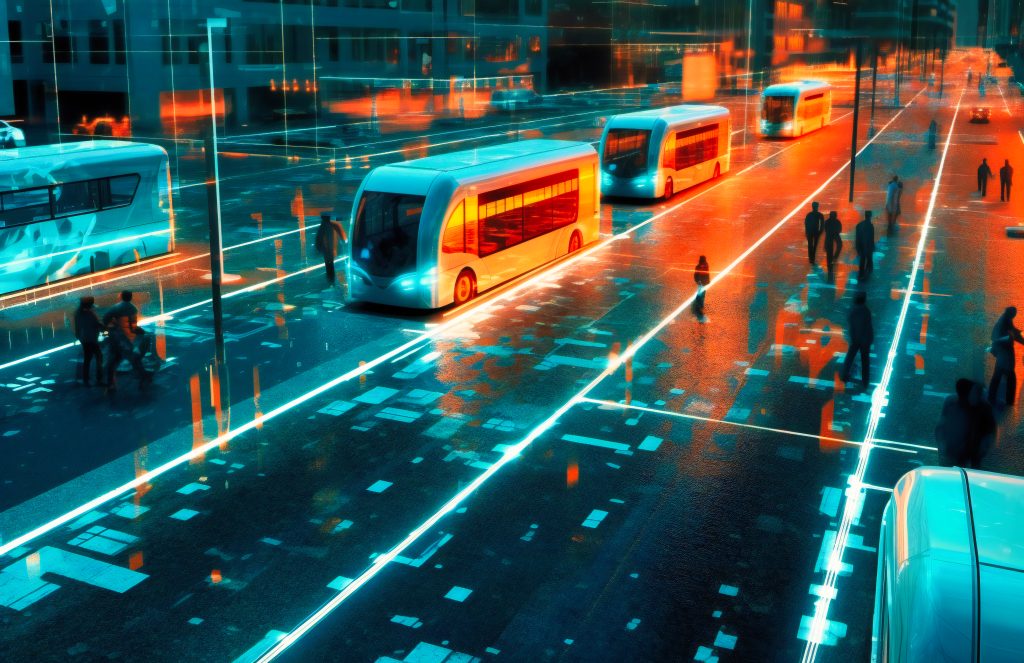Picture yourself sitting on a crowded bus, inching forward in a sea of cars, wondering if there’s a better way to reach your destination without all the frustration. Well, wonder no more. The solution lies in the powerful capabilities of artificial intelligence (AI) to optimize bus routes and transform your daily commute into a seamless and efficient experience. But how exactly does AI achieve this? How can it analyze traffic patterns, adapt to real-time changes, and integrate into existing systems? In this discussion, we will uncover the secrets behind AI’s ability to revolutionize bus route optimization, providing you with a glimpse into the future of transportation. Get ready to discover a whole new world of efficiency and convenience.
Challenges in Bus Route Optimization
Optimizing bus routes poses several challenges that require careful consideration and strategic planning. One of the major challenges is data collection. To optimize bus routes effectively, accurate and comprehensive data on passenger demand is crucial. Collecting this data can be challenging as it requires analyzing various factors such as peak travel times, popular destinations, and demographic information. Without reliable data, it becomes difficult to accurately evaluate passenger demand and make informed decisions regarding route optimization.
Another challenge is optimizing bus schedules. Bus schedules need to be carefully designed to ensure that they align with passenger demand while also considering factors like traffic patterns and travel times. Achieving this balance requires analyzing vast amounts of data and using algorithms to optimize schedules accordingly. Additionally, environmental factors such as air quality and traffic congestion need to be taken into account when optimizing bus routes. By considering these factors, it is possible to reduce the environmental impact of public transportation and promote sustainable travel options.
Addressing public concerns is also a crucial aspect of bus route optimization. Public input and feedback are valuable in identifying areas of improvement and addressing community needs. Engaging with the public through surveys, meetings, and social media platforms can help identify concerns such as accessibility, safety, and convenience. By actively addressing these concerns, public transportation authorities can build trust and encourage greater ridership.
Role of AI in Analyzing Traffic Patterns
AI plays a crucial role in analyzing traffic patterns, enabling more efficient and informed decision-making in bus route optimization. By predicting congestion, AI algorithms can identify areas with high traffic volume and plan alternative routes to avoid delays and reduce travel time. This data-driven approach allows for the optimization of bus stop locations, ensuring that stops are strategically placed in areas with high demand and reducing unnecessary stops that can slow down the overall route. By considering factors such as historical traffic data, real-time data feeds, and weather conditions, AI can provide accurate and up-to-date information for route planning.
Furthermore, AI can also contribute to reducing the carbon footprint of bus routes. By optimizing routes, minimizing idle time, and reducing unnecessary detours, AI can help buses run more efficiently, resulting in lower fuel consumption and emissions. Additionally, AI-powered systems can analyze data on passenger demand and optimize bus sizes and frequencies accordingly, leading to better resource allocation and reduced empty trips.
Benefits of Ai-Powered Route Optimization
Route optimization powered by AI offers numerous benefits, including improved efficiency, reduced travel time, and lower fuel consumption. By leveraging advanced algorithms and real-time data analysis, AI-powered route optimization can significantly enhance the cost efficiency of bus operations. Optimized routes allow buses to cover more ground in less time, resulting in reduced fuel consumption and operating costs. This not only benefits the transportation agency but also contributes to a reduced environmental impact by minimizing carbon emissions.
Another significant advantage of AI-powered route optimization is the time savings it brings. By identifying the most efficient routes based on traffic patterns and passenger demand, AI can reduce travel time for bus passengers. This not only improves the overall passenger experience but also encourages more people to choose public transportation as a convenient and reliable option.
Furthermore, AI-powered route optimization enhances public transportation planning. By analyzing historical data and predicting future trends, AI algorithms can provide valuable insights for route planning and scheduling. This helps transportation agencies optimize their resources, allocate buses more effectively, and identify areas with high demand for additional services.
Collecting and Analyzing Data for Route Optimization
With the benefits of AI-powered route optimization established, the next step is to explore the process of collecting and analyzing data to achieve optimal bus routes. Effective data collection and analysis are crucial for improving route efficiency, enhancing passenger satisfaction, and reducing costs.
To collect relevant data, various sources can be utilized, such as GPS tracking systems, passenger feedback, and historical travel patterns. GPS tracking systems provide real-time information on bus locations, allowing for accurate data on travel times and congestion levels. Passenger feedback, obtained through surveys or mobile applications, can offer insights into preferences, popular destinations, and areas for improvement. Historical travel patterns can be analyzed to identify peak hours, busiest routes, and areas with high demand.
Once the data is collected, sophisticated analysis techniques can be applied to identify patterns and derive actionable insights. Machine learning algorithms can be utilized to predict travel times, optimize bus stop locations, and identify the most efficient routes. Analysis of passenger feedback can reveal areas for route adjustments or improvements to enhance passenger satisfaction. Additionally, cost analysis can help identify opportunities for cost reduction, such as optimizing fuel consumption or reducing idle time.
Adapting to Real-Time Changes in Bus Routes
To ensure optimal efficiency and responsiveness, bus routes must be capable of adapting to real-time changes in traffic conditions and passenger demand. Here’s how AI and machine learning can help achieve this:
- Real-time updates: AI algorithms can continuously analyze data from various sources, such as GPS trackers, traffic cameras, and passenger feedback, to provide real-time updates on traffic congestion and other disruptions. This allows bus operators to make immediate adjustments to routes and schedules, minimizing delays and improving operational efficiency.
- Predictive analytics: By leveraging historical data and machine learning models, AI can predict future traffic patterns and passenger demand. This enables bus operators to proactively plan route adjustments and allocate resources accordingly. For example, if an upcoming event is expected to cause heavy traffic in a certain area, AI can suggest alternative routes to avoid congestion and ensure smooth operations.
- Dynamic routing: AI algorithms can dynamically optimize bus routes based on real-time data. By considering factors like traffic conditions, passenger demand, and operational constraints, AI can suggest the most efficient and effective route for each bus in real-time. This not only reduces travel time but also ensures that buses are evenly distributed to meet passenger demand.
- Passenger-centric approach: AI can analyze passenger data, such as boarding and alighting patterns, to identify areas with high demand. By adjusting routes to better serve these areas, bus operators can enhance passenger satisfaction and attract more ridership. Additionally, AI can analyze passenger feedback and preferences to further fine-tune route adjustments and improve the overall passenger experience.
Integrating AI Algorithms Into Existing Systems
As bus routes adapt to real-time changes, integrating AI algorithms into existing systems enables efficient and responsive adjustments based on data analysis and predictive analytics. However, there are several challenges in the implementation of AI algorithms in bus route optimization. One of the main challenges is the integration with existing infrastructure. Bus systems often have complex networks and established processes, making it difficult to seamlessly incorporate AI algorithms. Additionally, scalability concerns arise when implementing AI algorithms on a large scale. The algorithms must be able to handle the increasing demands of a growing bus network without compromising performance. Another important consideration is the impact on efficiency. While AI algorithms have the potential to optimize bus routes and improve overall efficiency, they must be carefully designed and calibrated to ensure that they do not disrupt the existing operations. Finally, user acceptance is crucial in the successful integration of AI algorithms. Bus operators and passengers need to trust and understand the algorithms for them to be fully adopted and utilized. Overcoming these challenges and effectively integrating AI algorithms into existing systems can greatly enhance the efficiency and effectiveness of bus route optimization.
Future Implications of AI in Bus Route Optimization
AI-driven bus route optimization has the potential to revolutionize transportation efficiency and improve passenger experience. As this technology continues to advance, it is important to consider the future implications it may have. Here are four key areas to consider:
- Ethical considerations in AI-powered bus route optimization: As AI algorithms make decisions about bus routes, ethical considerations arise. It is crucial to ensure that these algorithms prioritize fairness and equity, avoiding any potential biases or discrimination.
- Impact of AI on public transportation efficiency: AI can greatly enhance the efficiency of public transportation systems. By optimizing bus routes, AI algorithms can reduce travel time, increase on-time performance, and decrease overcrowding. This leads to a more efficient and reliable transportation network.
- Future challenges and opportunities in AI-based bus route optimization: While AI has the potential to bring significant improvements, there are challenges that need to be addressed. These include integrating AI algorithms into existing transportation systems, managing data privacy concerns, and adapting to changing traffic patterns and demand.
- Socio-economic implications of optimized bus routes using AI: Optimized bus routes can have positive socio-economic implications. By reducing travel time and congestion, AI-powered bus route optimization can improve productivity, enhance accessibility to employment and education opportunities, and reduce transportation costs for individuals and communities.
Read next:



